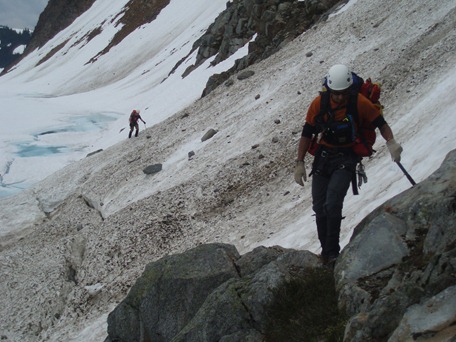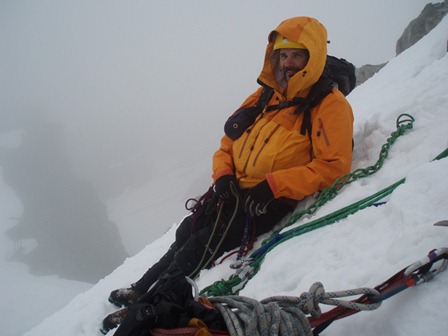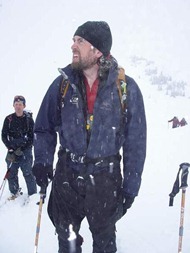Why SAR members are tough on gear
What, do you think, is the primary difference between a SAR member on a task, and a person undertaking a hiking, backcountry skiing or mountaineering trip? On the surface they look to be the same thing. We use the same types of equipment; boots, skis, poles, snowshoes and whatnot. We appear to be doing the same things; in the winter we ski and snowshoe, in the summer we hike and climb using the same tools, techniques and best practises as everyone else. But there is a fundamental difference.
A regular hiker/skier/climber/mountaineer has the luxury of choosing both the day and the route. By choosing the day I mean that a standard outdoor recreationalist can decide what day to do a trip based on weather and other conditions. They can also decide not to go, or to change the destination for a location with better weather or conditions.
In addition, regular backcountry travelers can choose the route they take to their given objective. By this I mean that when someone travels in the backcountry they make small choices on the route that result in easier or faster travel – for instance making the simplest choice of walking on a trail rather than bushwhacking, or when in the bush choosing to move through areas that are less dense, less swampy, or in general easier to get through. On a mountain, they can chose the easiest, cleanest or most aesthetic route.
This is not to say that all outdoors people are fair-weather hikers. I’ve seen my fair share of bad weather while on multi-day trips, and an enormous amount of bush when mountaineering. Mistakes in route-finding always end up with grief in the form of bush, swamp, bugs, cliffs, etc. The difference is that in the SAR experience sends you into the most difficult terrain deliberately.
SAR members can’t choose the time or day. Searches happen when the subjects get into trouble, and although we can’t predict when this will happen it seems to be highly co-related with less than optimum weather. In some ways this makes sense; bad weather is often the first factor contributing to an incident, or the first “edge” in a corner case. The weather prompts bad decisions, panic and contributes to injury by making dry surfaces slippery. Also, while some people might be able to handle an unplanned night out, if the weather turns bad they will call for help. Accidents and misadventures don’t usually happen on blue sky days.
The second difference is that SAR members often are not able to choose the route. This requires some explanation. Most searches, where the location of the subject is not known, don’t involve trails except for the first stages of the search. This may be a feature of the Lower Mainland, but the trails here are busy, and most people can’t really get lost when there are other people available to ask for directions. An example was a search on Grouse Mountain several years ago. All of the trails were covered in the first 3-4 hours. For the remaining 11 days of the task, all searching was done off trail.
Off trail searching involves three types: travelling and sound sweeping, where the search team moves through the terrain, periodically blowing whistles and making noise to attract the attention of the subject, purposeful wandering, where the search team spreads out across a very wide area and looks for tracks, clues and perhaps unresponsive subjects, and grid searching where the teams are spaced in a regular grid and walk slowly through the terrain. In each of these cases the route is often dictated by the SAR managers with a given goal – in some cases the sound sweep is near gullies and other terrain traps, the purposeful wandering may be in high areas of probability, and the grid search is often for a body or for evidence in a pre-determined area.
In all three cases, the team is told where to go. Most of the time the route in and route out of a search area are reasonable, but once on the task, the route is dictated and in my experience is often not the way any rational outdoor enthusiast would pick. Often, the difficult terrain that we are sent into is exactly where the subjects have ended up, because if they stayed in the reasonable, and easy to travel terrain they would not have become lost, or injured in the first place.
A contributing factor is that most SAR responses are at night. A quick response, and an all-out attempt to locate a subject in the first 8-12 hours has been shown to be the most effective at preventing death and further injury. At night it is harder to navigate, and thus harder to pick less dense bush, or less swampy terrain. Often we’re faced with travelling cross-country, following a compass bearing and using a GPS to track where we’ve been.
A final note on the amount of gear. For a regular hike a person may take the 10 essentials, some food, clothing, water and the like. SAR members tend to carry more to start with, including first aid kits, specialised rescue equipment, and saws to make helicopters LZs
The comparison of SAR members to regular hikers, climbers and skiers is perhaps the wrong group to compare with. We have much more in common with prospectors, timber cruisers, and BC Forest Fire Fighters, all groups who have to travel in the bush with goals that are quite different from outdoor recreation.
As an aside, I’ve been part of two huge searches that used forest service fire fighters as searchers in seasons with low fire hazard. Those guys are professionals! They can walk through the bush for 16 hours a day, completely self-sufficient, and without complaint. I guess what there’s no smoke, ash and heat it seems like a walk in the park for them.
The result of all this wandering around in the bush and swamp is that SAR gear takes quite a bit of wear and tear for the unusual use we put it through. I encourage any companies that make outdoor equipment to consider sending some gear out way for testing if you’re at all interested in durability.





Leave a Reply